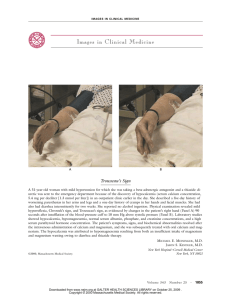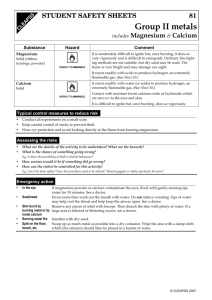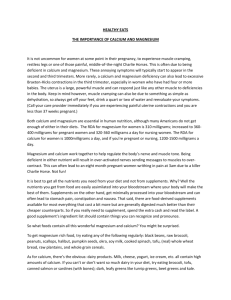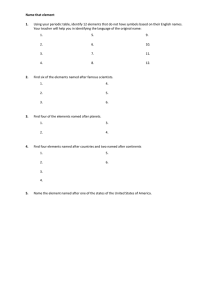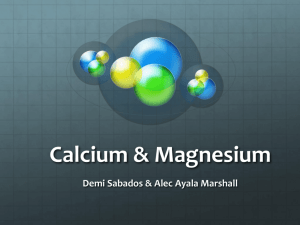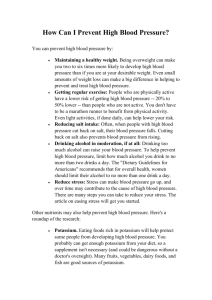Stability and Broad-Sense Heritability of Mineral Content
advertisement
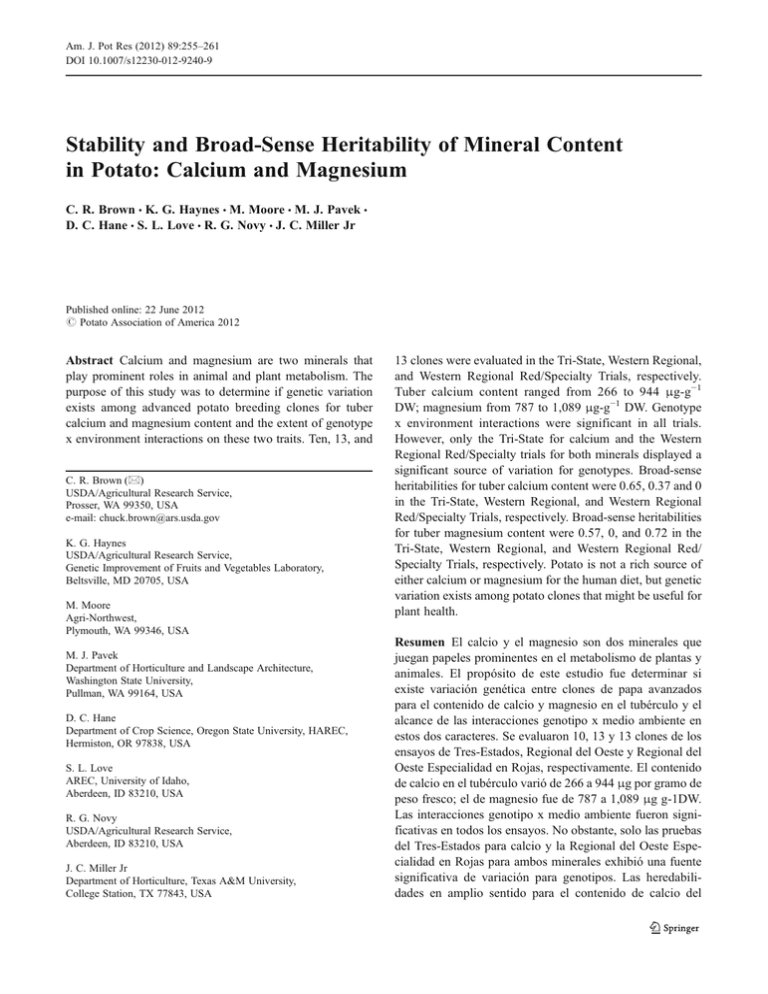
Am. J. Pot Res (2012) 89:255–261 DOI 10.1007/s12230-012-9240-9 Stability and Broad-Sense Heritability of Mineral Content in Potato: Calcium and Magnesium C. R. Brown & K. G. Haynes & M. Moore & M. J. Pavek & D. C. Hane & S. L. Love & R. G. Novy & J. C. Miller Jr Published online: 22 June 2012 # Potato Association of America 2012 Abstract Calcium and magnesium are two minerals that play prominent roles in animal and plant metabolism. The purpose of this study was to determine if genetic variation exists among advanced potato breeding clones for tuber calcium and magnesium content and the extent of genotype x environment interactions on these two traits. Ten, 13, and C. R. Brown (*) USDA/Agricultural Research Service, Prosser, WA 99350, USA e-mail: chuck.brown@ars.usda.gov K. G. Haynes USDA/Agricultural Research Service, Genetic Improvement of Fruits and Vegetables Laboratory, Beltsville, MD 20705, USA M. Moore Agri-Northwest, Plymouth, WA 99346, USA M. J. Pavek Department of Horticulture and Landscape Architecture, Washington State University, Pullman, WA 99164, USA D. C. Hane Department of Crop Science, Oregon State University, HAREC, Hermiston, OR 97838, USA S. L. Love AREC, University of Idaho, Aberdeen, ID 83210, USA R. G. Novy USDA/Agricultural Research Service, Aberdeen, ID 83210, USA J. C. Miller Jr Department of Horticulture, Texas A&M University, College Station, TX 77843, USA 13 clones were evaluated in the Tri-State, Western Regional, and Western Regional Red/Specialty Trials, respectively. Tuber calcium content ranged from 266 to 944 μg-g−1 DW; magnesium from 787 to 1,089 μg-g−1 DW. Genotype x environment interactions were significant in all trials. However, only the Tri-State for calcium and the Western Regional Red/Specialty trials for both minerals displayed a significant source of variation for genotypes. Broad-sense heritabilities for tuber calcium content were 0.65, 0.37 and 0 in the Tri-State, Western Regional, and Western Regional Red/Specialty Trials, respectively. Broad-sense heritabilities for tuber magnesium content were 0.57, 0, and 0.72 in the Tri-State, Western Regional, and Western Regional Red/ Specialty Trials, respectively. Potato is not a rich source of either calcium or magnesium for the human diet, but genetic variation exists among potato clones that might be useful for plant health. Resumen El calcio y el magnesio son dos minerales que juegan papeles prominentes en el metabolismo de plantas y animales. El propósito de este estudio fue determinar si existe variación genética entre clones de papa avanzados para el contenido de calcio y magnesio en el tubérculo y el alcance de las interacciones genotipo x medio ambiente en estos dos caracteres. Se evaluaron 10, 13 y 13 clones de los ensayos de Tres-Estados, Regional del Oeste y Regional del Oeste Especialidad en Rojas, respectivamente. El contenido de calcio en el tubérculo varió de 266 a 944 μg por gramo de peso fresco; el de magnesio fue de 787 a 1,089 μg g-1DW. Las interacciones genotipo x medio ambiente fueron significativas en todos los ensayos. No obstante, solo las pruebas del Tres-Estados para calcio y la Regional del Oeste Especialidad en Rojas para ambos minerales exhibió una fuente significativa de variación para genotipos. Las heredabilidades en amplio sentido para el contenido de calcio del 256 Am. J. Pot Res (2012) 89:255–261 tubérculo fueron de 0.65, 0.37 y 0 para los ensayos de TresEstados, Regional del Oeste, y Regional del Oeste Especialidad en Rojas respectivamente. Las heredabilidades en amplio sentido para el contenido de magnesio en el tubérculo fueron de 0.57, 0 y 0.72, en los ensayos de TresEstados, Regional del Oeste y Regional del Oeste Especialidad en Rojas, respectivamente. La papa no es una fuente rica ni de calcio ni de magnesio para la dieta humana, pero existe variación genética entre los clones de papa que pudieran ser útiles para la sanidad de la planta. calcium or magnesium deficiency (Frossard et al. 2000). Neither calcium nor magnesium are thought to be particular crucial as macronutrients in human nutrition. Calcium is most often in a deficient status in the diet where populations do not have access to dairy products. The purpose of this study was to quantify variation of calcium and magnesium among advanced potato selections in several regional trials and to estimate broad-sense heritability, relating this to potato physiology and the human diet. Keywords Solanum tuberosum . Genotype x environment interaction . Breeding . ICAEPS . Biofortification Materials and Methods Introduction Calcium is rarely deficient in soils but may present plant uptake problems on acidic soils. Vegetables may show quality reduction as a result of calcium disorders (Bangerth 1979). Ca deficiency may arise in the whole plant, or in a particular organ of the plant, but relatively little is known about the way in which Ca deficiency causes the observed symptoms. Typically, the symptoms of calcium deficiency, in addition to growth reduction, also comprise browning phenomena and, in severe cases, necrosis of whole areas of plant tissue. In contrast to other macronutrients, a high proportion of the total calcium in plant tissue is located in the cell wall (apoplast). The main known functions of Ca in the apoplast are to maintain the integrity of the plasmalemma and to stabilize the pectins both intra- and intermolecularly (White and Broadley 2003). Calcium levels in potato plants have been implicated in resistance to internal brown spot (Tzeng et al. 1986), heat necrosis (Yencho et al. 2008), and infection by the soft rot pathogen Pectobacterium spp. (McGuire and Kelman 1984), heat tolerance (Kleinhenz and Palta 2002), and freezing tolerance (Vega et al. 1996). Higher levels of calcium and magnesium in cooking water reduced sloughing (disintegration) when boiling tubers of the cultivar Russet Burbank (Zaehringer and Cunningham 1971). Although magnesium is rarely limiting to plant growth, several studies have shown a dramatic yield increase in potato with the addition of magnesium on deficient soils (Chucka 1934; Sawyer and Dallyn 1966). Magnesium is present in chlorophyll, is essential in allowing ATP to function and in activating many enzymes needed in photosynthesis, respiration and the formation of DNA and RNA (Wilkinson et al. 1990). The range of variation and knowledge concerning the ratio of genetic variation to total phenotypic variation are useful in an assessment of the future prospects of taking potato from an insignificant source of calcium and magnesium to one that aids substantially in the alleviation of Field Experiments Potato genotypes in three distinct trials were planted at different locations in 2004. The 13 locations and associated crop management are described Brown et al. (2010; 2011). Each trial had a different array of genotypes. The Tri-state (TS) trials were comprised of four environments for each mineral, while the Western Regional Russet (WR) drew from 6 to 3 environments, for calcium and magnesium, respectively. The Western Specialty/Red Trials (W/SP/R) were grown in three environments for each mineral. Field trials were planted as randomized complete blocks, with four blocks. Plots consisted of 20 plants. Tubers were harvested mechanically and packaged out of the field and shipped to Prosser, WA. They were stored at 10 °C for 30 days at 85 % relative humidity. Three tubers from each plot were sliced, not peeled, dried, and ground to powder as a composite sample. Preparation of samples and analysis was described in Brown et al. (2010; 2011) Statistical Analysis Calcium content was transformed to the natural logarithm for all statistical analyses and backtransformed for presentation of means. Magnesium values were not transformed. Variance components for each source of variation were estimated from the mixed models procedure in SAS (version 9.1, Cary, NC). Broad-sense heritability (H) was estimated as the ratio of the genotypic (σ2G ) to total phenotypic variance, H ¼ σ2G = σ2error =re þ σ2GxE =e þ σ2G (Holland et al. 2003), where r0number of replications and e0number of environments. Knapp et al. (1985) determined the exact confidence interval for H. The upper confidence interval is 1-[(MS1/ MS2) F(1-α/2:df2,df1)]−1, while the lower confidence interval is 1[(MS1/MS2) F(α/2:df2,df1)]−1, where MS1 0mean squares for genotype and MS2 0mean squares for genotype x environment. These mean squares were obtained from the type III mean squares from the general linear models procedure in SAS. To evaluate the genetic stability of each potato genotype, the genotype x environment interaction (G x E) was partitioned into stability variance components (σ2i ) assignable to each genotype (Shukla 1972), using a program written for the interactive matrix language procedure in SAS (Kang Am. J. Pot Res (2012) 89:255–261 257 Table 1 Calcium content (μg-g−1 DW) by trial location and overall, and significance of the contribution each genotype makes to G x E variance (σ2i ), and residual (s2i ) after removal of environmental heterogeneity in the Tri-State trials Genotype TS-H1 TS-A2 TS-OE3 LT-OL4 Mean σ2i s2i A95409-1 1,288 623 865 998 944 ** ** A96023-6 A96095-3 1,131 561 677 850 1,232 1,097 447 794 872 826 ** ** * A96104-2 636 802 1,101 412 738 A98295-3TE AO96164-1a AOA95154-1b AOA95155-7 Russet Burbank 562 373 367 651 772 607 987 931 930 248 269 274 612 586 545 * ** * 308 886 643 562 1,032 631 332 1,004 579 771 ** ** ** Ranger Russet 910 644 628 360 636 * ** Location mean 702 683 943 514 * *0P<0.05, **0P<0.01, significance level of variances σ2i , and s2i 1 Hermiston, Oregon 2 Aberdeen, Idaho 3 Early harvest, Othello, Washington 4 Late harvest, Othello, Washington a Subsequently named ‘Sage Russet’ b Subsequently named ‘Clearwater Russet’ 1989). An environmental index for each environment was calculated by subtracting the grand mean over all environments from the mean for each environment. Heterogeneity due to this index was removed from the G x E interaction and the remainder was partitioned into s2i assignable to each potato genotype, and constitutes variance not explained by removal of environmental effects. Results and Discussion The analysis of the Tri-State trials included four environments in the Pacific Northwest, one in Aberdeen, ID, one in Hermiston, OR, and an early and late harvest in Othello, Table 2 Magnesium content (μg-g−1 DW) by trial location and overall, and significance of the contribution each genotype makes to G x E variance (σ2i ), and residual (s2i) after removal of environmental heterogeneity in the Tri-State trials *0P<0.05, **0P<0.01, significance level of variances σ2i, and s2i WA. Environments were not a significant source of variation for calcium, but G x E was. The stability analysis revealed that eight genotypes displayed significant G x E for calcium and six of these remained unstable after removal of environmental heterogeneity (Table 1). Both Russet Burbank and Ranger Russet, the most widely grown and the third most widely grown varieties in North America, respectively, displayed significant G x E and Ranger Russet remained unstable after environmental heterogeneity was removed. Magnesium content was analyzed over four environments. Genotypes and G x E were significant but environments were not. Four genotypes had significant G x E and three of these remained unstable after removal of environmental heterogeneity (Table 2). In addition, one genotype did not Genotype TS-H TS-A TS-OE TS-OL Genotype mean σ2i s2i A95409-1 A96023-6 A96095-3 A96104-2 A98295-3TE AO96164-1 AOA95154-1 AOA95155-7 Ranger Russet Russet Burbank Location mean 1,126 1,303 1,070 1,030 1,030 1,030 976 1,118 946 896 1,053 752 861 968 1,035 842 887 877 1,092 864 877 906 657 810 780 856 756 806 817 783 697 693 766 980 962 920 854 837 872 748 1,074 769 839 886 879 984 935 944 866 899 855 1,017 819 826 ** ** ** ** ** ** ** ** 258 Am. J. Pot Res (2012) 89:255–261 Table 3 Calcium content (μg-g−1 DW) by trial location and overall, and significance of the contribution each genotype makes to G x E variance (σ2i ), and residual (s2i ) after removal of environmental heterogeneity in the Western Regional Russet trial entries Genotype WR-K1 WR-S2 WR-EH3 WR-A4 WR-OE5 WR-OL6 Genotype mean σ2i s2i A92030-5 528 627 475 493 232 691 508 ** ** A92294-6 A9304-3 447 342 354 578 345 508 695 629 746 643 300 381 480 749 667 328 539 453 603 408 241 212 317 245 425 371 377 419 662 456 366 424 442 597 491 ** * ** ** ** ** ** 378 369 379 772 775 706 1,038 484 401 536 575 683 272 332 327 539 375 485 589 485 497 ** * * ** ** ** 528 452 627 694 440 1,011 532 286 472 578 428 721 236 296 459 458 365 536 504 378 638 ** ** ** ** 479 353 566 734 213 618 494 ** ** 447 661 525 545 293 489 A9305-10a A93157-6LSb A95109-1c AC92009-4 AC93026-9 AO96160-3d ATX92230-1 CO93001-11 CO94035-15e PA95A11-14 Location mean *0P<0.05, **0P<0.01, significance level of variances σ2i , and s2i 1 Kimberly, Idaho 2 Springlake, Texas 3 Early harvest, Hermiston, Oregon 4 Aberdeen, Idaho 5 Early harvest, Othello, Washington 6 Late harvest, Othello, Washington a/ Subsequently named ‘Alpine Russet’ b/ Subsequently named ‘Premier Russet’ c/ Subsequently named ‘Classic Russet’ d/ Subsequently named ‘Owyhee Russet’ e/ Subsequently named ‘Mesa Russet’ show significant G x E but had significant instability after removal of environmental heterogeneity. Magnesium Table 4 Magnesium content (μg-g−1 DW) by trial location and overall, and significance of the contribution each genotype makes to G x E variance (σ2i ), and residual (s2i) after removal of environmental heterogeneity in the western regional Russet trials *0P<0.05, **0P<0.01, significance level of variances σ2i, and s2i 1 Early harvest, Hermiston, Oregon 2 Early harvest, Othello, Washington 3 Late harvest, Othello, Washington content means over environments ranged from 766 to 1,053 μg-g−1 DW. WR-OE2 WR-OL3 Genotype mean σ2i s2i 1,319 703 869 964 ** ** 885 1,015 959 1,074 972 1,015 966 1,090 1,118 928 1,018 1,109 1,036 798 920 948 862 1,011 789 897 946 796 899 979 770 871 688 744 773 816 811 755 705 777 877 876 791 763 788 790 893 893 917 931 853 856 938 930 901 929 881 * * ** ** Genotype WR-EH1 A92030-5 A92294-6 A9304-3 A9305-10 A93157-6LS A95109-1 AC92009-4 AC93026-9 AO96160-3 ATX92230-1 CO93001-11 CO94035-15 PA95A11-14 Location mean * ** ** * ** ** * * Am. J. Pot Res (2012) 89:255–261 259 Table 5 Calcium content (μg-g−1 DW) by trial location and overall, and significance of the contribution each genotype makes to G x E variance (σ2i ), and residual (s2i ) after removal of environmental heterogeneity in the Western Regional Red/Specialty Trials Genotype W/SP/R-H1 W/S/SP/R-A2 W/SP/R-M3 Genotype mean σ2i A96741-1R 448 444 301 398 ** A96741-2R AO93487-2Ra All Blue BTX1544-2 440 241 524 370 254 269 406 293 * * 275 260 461 530 250 212 329 334 CO93037-6R 285 154 233 290 330 452 375 668 223 191 347 211 279 266 318 390 289 442 350 664 242 252 294 453 VC1015-7 328 665 229 407 Yukon Gold 211 835 203 416 Location mean 300 513 245 CO94165-3b CO94183-1c NDA5507-3d VC0967-2 VC1002-3 s2i * * ** ** * ** ** * ** * *0P<0.05, **0P<0.01, significance level of variances σ2i , and s2i 1 Hermiston, Oregon 2 Aberdeen, Idaho 3 Mount Vernon, Washington a Subsequently named ‘Red Sunset’ b Subsequently named ‘Purple Majesty’ c Subsequently named ‘Mountain Rose’ d Subsequently named ‘Yukon Gem’ The Western Regional Russet Trial was tested over six environments for calcium: two environments in Idaho, one in Texas, one in Oregon, and two in Washington. There were no significant differences among environments or genotypes, but the G x E interaction was significant. Eleven genotypes Table 6 Magnesium content (μg-g−1 DW) by trial location and overall, and significance of the contribution each genotype makes to G x E variance (σ2i ), and residual (s2i) after removal of environmental heterogeneity in the Western Regional Red/ Specialty Trials *0P<0.05, **0P<0.01, significance level of variances σ2i, and s2i exhibited significant G x E and ten remained unstable after removal of environmental heterogeneity (Table 3). Data were obtained from three environments for magnesium. Neither genoytpes nor environments were significant, but G x E was. Seven genotypes showed significant G x E and six of Genotype W/SP/R-H W/SP/R-A W/SP/R-M Genotype mean A96741-1R 1015 1,064 717 932 A96741-2R AO93487-2R All Blue BTX1544-2 CO93037-6R CO94165-3 CO94183-1 NDA5507-3 VC0967-2 VC1002-3 VC1015-7 Yukon Gold Location mean 1,149 1,065 759 1,194 860 886 1,091 961 1,165 1,007 1,210 990 1,027 1,294 1,222 950 1,109 796 886 1,020 1,108 1,138 920 1,092 915 1,040 825 778 652 893 733 678 840 973 772 812 697 826 784 1,089 1,022 787 1,065 796 817 984 1,014 1,025 913 1,000 910 σ2i s2i ** ** ** * * ** ** ** ** * ** * ** 260 Am. J. Pot Res (2012) 89:255–261 these were unstable when environmental heterogeneity was removed (Table 4). In addition, one genotype did not show significant G x E but had significant instability after removal of environmental heterogeneity. The Western Regional Red/Specialty trial was grown in three environments in the Pacific Northwest. For calcium, genotypes and G x E were significant, but environments were not. Eight genotypes showed significant G x E and five were unstable after removal of environmental heterogeneity (Table 5). Calcium content ranged from 266 to 453 μg-g−1 dry weight. Magnesium contents were likewise obtained from three environments. Genotypes and G x E were significant while environments were not. The mean over the three environments ranged from 787 to 1,089 micrograms per gram dry weight. Nine genotypes displayed significant G x E and four remained unstable after removal of environmental heterogeneity (Table 6). Broad-Sense Heritability Broad-sense heritability refers to the ratio of all genetic variation to total phenotypic variation. It is therefore not a predictor of expected gain from sexual breeding and selection, but rather a predictor of change effected by selection among the individuals in that population. Broad-sense heritabilities for calcium content and their 95 % confidence intervals were 0.65 (0.25, 0.88), 0.37 (−0.66, 0.88), and 0 for the Tri-State, Western Regional and Western Regional Red/Specialty Trials, respectively. Broad-sense heritabilities for magnesium content and their 95 % confidence intervals were 0.57 (0.14, 0.91), 0, and 0.72 (0.23, 0.90) for the TriState, Western Regional and Western Regional Red/Specialty Trials, respectively (Table 7). From these results it may be surmised that certain populations of breeding lines would increase in calcium and magnesium if selection were Table 7 Broad-sense heritability (H) of calcium and magnesium content in the Tri-State, western regional Russet, and western regional red/ specialty Tri-State Western regional Broad-sense heritability (H) Ca H 0.65 Upper CI 0.88 Lower CI 0.250 Broad-sense heritability (H) Mg H 0.57 Upper CI 0.91 Lower CI 0.14 CI confidence interval na not applicable 0.37 0.88 −0.66 0 na na Western regional red/specialty 0 na na 0.72 0.90 0.23 applied. Broad-sense heritability does not isolate additive genetic variance which would predict genetic gain due to intermating and selection. It is applicable to vegetatively propagated crops in the sense that, when significant, it predicts gain by selection within a group of genotypes that will not change genetically from this generation into the next. Gain in a selected subset is predicted to occur in proportion of the relative magnitude of the genetic variance versus total phenotypic variance. Selection among clones will result in highest gain where H is highest, e.g. for calcium among the Tri-State entries, and for magnesium among the Tri-State and Western Regional Red/Specialty trials. These breeding lines represent a small fraction of the total variation to be accessed in potato germplasm and a more thorough survey the Cultivated Collection of the International Potato Center or of wild accessions in the USDA/ARS Potato Germplasm Collection of Sturgeon Bay, Wisconsin, might provide a greater range to choose from. The calcium and magnesium contents are in conformity with a summary in Rastovski and van Es (1987). Andre et al. (2007) found calcium contents ranging from from 271 to 1,092 μg-g−1 DW in native South American cultivars. A study of wild tuber bearing species found levels of calcium ranging from 160 to 743 μg-g−1 under low calcium nutrient levels and from 474 to 1,829 μg-g−1 under high calcium levels in nutrient solution (Bamberg et al. 1993). In a follow-up survey, Bamberg et al. (1998) reported levels as high as 2,166, 2,168 and 2,121 μg-g−1 in specific selections of S. kurtzianum, S. microdontum, and S. gourlayi, respectively, under enhanced calcium fertilization. CasañasRivero et al. (2003) found that older varieties on the Canary Islands had higher values of calcium, but that this did not hold true for magnesium. Chuño is a dried potato product derived from bitter frost tolerant potatoes grown at high elevations in the Andes. The final product is a waterleached, freeze-dried food storable for long periods of time. The processing of chuño has been reported to increase calcium concentration by 25 % and decrease magnesium concentration by 75 % (de Haan et al. 2010). At present, in the US population, potatoes contribute 4.5 % of the magnesium in the diet (Subar et al. 1998). A 100 g FW portion of our highest calcium potato genotype (approx. 18 mg) would provide a male adult 2 % of the Recommended Daily Allowance (RDA). The same amount would constitute 2 % of the RDA for children 4 to 8 years. The same weight of potato provides 5 % percent of the RDA of magnesium for adult men and 15 % of RDA for infants 4 to 8 years old months (http://ods.od.nih.gov/factsheets/magnesium; http:// ods.od.nih.gov/factsheets/calcium). The daily requirements for macronutrients calcium and magnesium in the human diet are large compared to micronutrients iron and zinc. Even though potato contains much larger amounts of calcium and magnesium than of iron or zinc Am. J. Pot Res (2012) 89:255–261 (Brown et al. 2010; Brown et al. 2011), it is not a rich source of either, because the RDA is high. Although it is likely that increases could be achieved by breeding it is doubtful that potato would ever be a considered an abundant source of either mineral in the diet. Common bean (Phaseolus vulgaris) has roughly ten times more calcium and magnesium than potato, for instance (Woolfe 1987). Calcium and magnesium contents may be of greater significance in the control of physiological disorders and diseases of potato and therefore may be more worthy of exploration at the high and low extremes of concentration of these two minerals with these objectives in mind. References Andre, C.M., M. Ghislain, P. Bertin, O. Mouhssin, M. del Rosario Herrera, L. Hoffmann, J.-F. Hausman, Y. Larondelle, and D. Evers. 2007. Andean potato cultivars (Solanum tuberosum L.) as a source of antioxidant and mineral micronutrients. Journal of Agricultural and Food Chemistry 55: 366–378. Bamberg, J.B., J.P. Palta, L.A. Peterson, M. Martin, and A.R. Krueger. 1993. Screening tuber-bearing Solanum (Potato) germplasm for efficient accumulation of tuber calcium. American Potato Journal 70: 219–226. Bamberg, J.B., J.P. Palta, L.A. Peterson, M. Martin, and A.R. Krueger. 1998. Fine screening potato (Solanum) species germplasm for tuber calcium. American Journal of Potato Research 75: 181–186. Bangerth, F. 1979. Calcium-related physiological disorders of plants. Annual Review of Phytopathology 17: 97–122. Brown, C.R., K.G. Haynes, M. Moore, M.J. Pavek, D.C. Hane, S.L. Love, R.G. Novy, and J.C. Miller Jr. 2010. Stability and broadsense heritability of mineral content in potato: Iron. American Journal of Potato Research 87: 390–396. Brown, C.R., K.G. Haynes, M. Moore, M.J. Pavek, D.C. Hane, S.L. Love, R.G. Novy, and J.C. Miller Jr. 2011. Stability and broadsense heritability of mineral content in potato: Zinc. American Journal of Potato Research 88: 238–244. Casañas-Rivero, R., P. Suárez-Hernández, E.M. Rodríguez-Rodríguez, J. Darias-Martín, and B.C. Díaz-Romero. 2003. Mineral concentrations in cultivars of potatoes. Food Chemistry 83: 247–253. Chucka, J. 1934. Magnesium deficiency in Aroostook potato soils. American Potato Journal 11: 29–35. de Haan, S., G. Burgos, J. Arcos, R. Ccanto, M. Scurrah, E. Salas, and M. Bonierbale. 2010. Traditional processing of black and white chuño in the Peruvian Andes: Regional variants and effect on the mineral content of native potato cultivars. Economic Botany 64: 217–234. Frossard, E., M. Bucher, F. Mächler, A. Mozafar, and R. Hurrell. 2000. Potential for increasing the content and bioavailability of Fe, Zn 261 and Ca in plants for human nutrition. Journal of the Science of Food and Agriculture 80: 861–879. Holland, J.B., W.E. Nyquist, and C.T. Cervantes-Martinez. 2003. Estimating and interpreting heritability for plant breeding: An update. Plant Breeding Reviews 22: 9–112. Kang, M.S. 1989. A new SAS program for calculating stabilityvariance parameters. Journal of Heredity 80: 415. Kleinhenz, M.D., and J.P. Palta. 2002. Root zone calcium modulates the response of potato plants to heat stress. Physiologia Plantarum 115: 111–118. Knapp, S.J., W.W. Stroup, and W.M. Ross. 1985. Exact confidence intervals for heritability on a progeny mean basis. Crop Science 25: 192–194. McGuire, R.G., and A. Kelman. 1984. Reduced severity of Erwinia soft rot in potato tubers with increased calcium content. Phytopathology 74: 1250–1256. Rastovski, A., and A. van Es. 1987. Storage of potatoes: Post-harvest behaviour, store design, storage practice, handling, 453. Pudoc: Wageningen. Sawyer, R.L., and S.L. Dallyn. 1966. Magnesium fertilization of potatoes on Long Island. American Potato Journal 43: 249– 252. Shukla, G.K. 1972. Some statistical aspects of partitioning genotypeenvironment components of variability. Heredity 29: 237– 245. Subar, A.F., S.M. Krebs-Smith, A. Cook, and L.L. Kahle. 1998. Dietary sources of nutrients among US adults, 1989 to 1991. Journal of the American Dietetic Association 98: 537–547. Tzeng, K.C., A. Kelman, K.E. Simmons, and K.A. Kelling. 1986. Relations of calcium nutrition to internal brown spot of potato tubers and sub-apical necrosis of sprouts. American Potato Journal 63: 87–97. Vega, S.E., J.A. Bamberg, and J.P. Palta. 1996. Potential for improving freezing stress tolerance of wild potato germplasm by supplemental calcium fertilization. American Journal of Potato Research 73: 397–409. White, P.J., and R.B. Broadley. 2003. Calcium in plants. Annals of Botany 92: 487–511. Wilkinson, S.R., R.M. Welch, H.F. Mayland, and D.L. Grunes. 1990. Magnesium in plants: Uptake, distribution, function and utilization by man and animals. In Metal ions in biological systems. Vol 26. Compendium on magnesium and its role in biology, nutrition and physiology, ed. H. Sigel and A. Sigel, 30–56. New York: Marcel Dekker. Woolfe, J.A. 1987. The potato in the human diet, 237. Cambridge: Cambridge University Press. Yencho, G.C., P.H. McCord, K.G. Haynes, and S.B. Sterrett. 2008. Internal heat necrosis of potato—A review. American Journal of Potato Research 85: 69–76. Zaehringer, M.V., and H.H. Cunningham. 1971. Potato extractives: Sloughing as related to replacement of anions or cations. American Potato Journal 48: 385–389.
